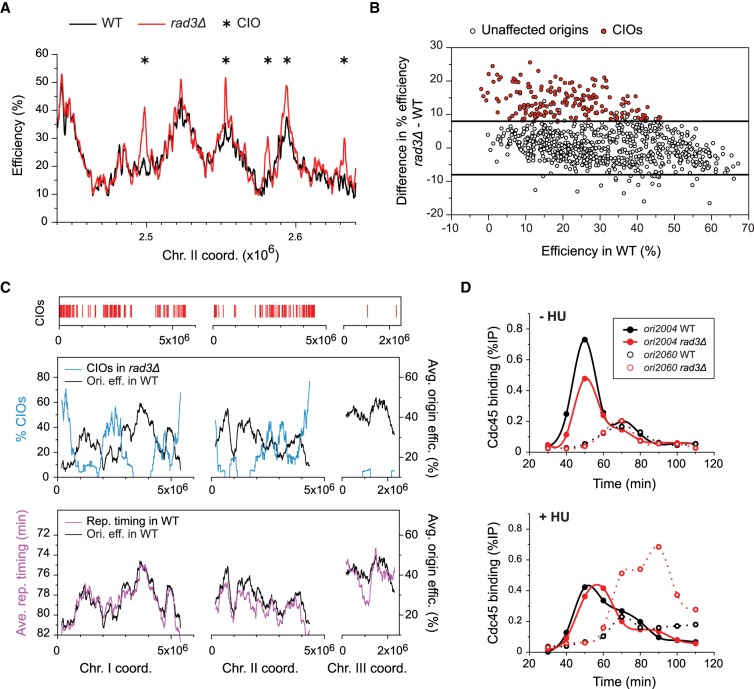Figure 1.
Regional de-regulation of origin firing in checkpoint-defective cells exposed to replication stress. (A) Origin efficiencies in a representative region of the genome for cdc25-22 (black, WT) and cdc25-22 rad3Δ (red, rad3Δ) cells in 6 mM HU (see Supplemental Fig. S1A,B for experimental design and flow cytometry analyses). Full profiles are shown in Supplemental Figure S1C. Asterisks mark CIOs. x-axis: chromosome coordinates; y-axis: origin efficiency. (B) Analysis of the absolute efficiency differences between rad3Δ and wild-type (WT) cells as a function of origin usage in WT (data from A and Supplementary Fig. S1C). x-axis: origin efficiency in WT; y-axis: differences in origin efficiency (rad3Δ − WT). Open circles: unaffected origins; red circles: CIOs (see Methods for CIO selection). Lines mark 8% differences in absolute origin efficiency. (C) Clustering of de-regulated origins in late-firing and inefficient chromosomal domains. Top: Red bars indicate positions of CIOs. Middle: Comparison of origin de-regulation in rad3Δ with the program of replication in WT. The percentages of CIOs in 1000-probe (∼250-kb) windows were determined across the genome (blue line, scale on left y-axis). The averages of origin efficiencies in WT were assessed for the same continuous windows (black line, scale on right y-axis). Bottom: The profiles of replication timing and efficiency in a wild-type background show identical regional characteristics. The average timings of origin firing were assessed for the same continuous windows as above (purple, left y-axis) (timing data from Heichinger et al. 2006). The profile of efficiency domains is as in the middle panel (black, right y-axis). x-axis: chromosome coordinates. Note that regions containing CIO clusters are also enriched in sites of inappropriate origin firing that were identified in previous studies (Supplemental Fig. S1E). (D) Time course of Cdc45 binding in cdc25-22 (WT, black) and cdc25-22 rad3Δ (rad3Δ, red) cells at an unaffected origin (ori2004, closed circles) and a CIO (ori2060, open circles). Cells were released from G2 arrest and sampled at the indicated time points. In replication stress conditions, ori2004 is used with an efficiency of ∼50% in wild type and rad3Δ, while the efficiency of ori2060 increases from 14% in wild type to 26% in rad3Δ (Supplemental Table S1). Top: −HU; bottom: 6 mM HU. x-axis: time after release; y-axis: Cdc45 occupancy (%IP).

